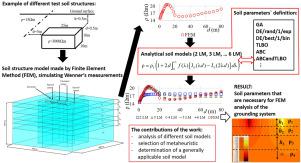Applied Soft Computing ( IF 7.2 ) Pub Date : 2020-07-13 , DOI: 10.1016/j.asoc.2020.106541 Marko Jesenik , Mladen Trlep

|
Grounding systems are an important part of protection systems, which protect people and devices in case of lightning strikes and defects in electro energetic systems. Grounding systems are often dimensioned using numerical models, among other numerical methods, also the Finite Element Method. Data about the soil in the surroundings of the grounding system are obtained using measurements. Soil parameters can be determined using analytical soil models. The determination of the soil models’ parameters is an optimisation problem which is based on the measured data. In this paper, different soil models are tested on different data, and compared with each other. Test data are also obtained using finite element models of different soil structures, which offer better analysis of the soil models because the soil structure is known. The horizontally, vertically layered soil and inhomogeneity in the soil are modelled. Different metaheuristics are used and tested for the determination of soil parameters: A Genetic Algorithm, Differential Evolution with two different strategies, Artificial Bee Colony, Teaching-Learning Based Optimisation and a combination of Artificial Bee Colony and Teaching-Learning Based Optimisation. Analysis of the models and solving methods are made based on the test results. As a result, the appropriate soil models among those tested are selected, which are 4, 5 and 6 layered models, and appropriate methods for parameters‘ determination are presented, which are Artificial Bee Colony and a combination of Artificial Bee Colony and Teaching-Learning Based Optimisation. Also, analysis is made of the usefulness of the horizontally multi-layered model for differently structured soils.
中文翻译:

基于从具有已知土壤结构的有限元模型获得的数据进行的多层土壤模型测试,使用元启发法确定参数
接地系统是保护系统的重要组成部分,可在雷击和高能系统故障时保护人员和设备。接地系统通常使用数值模型来确定尺寸,其中包括其他数值方法,还有有限元方法。通过测量获得有关接地系统周围土壤的数据。可以使用分析土壤模型确定土壤参数。土壤模型参数的确定是一个基于实测数据的优化问题。在本文中,不同的土壤模型在不同的数据上进行了测试,并进行了比较。还可以使用不同土壤结构的有限元模型获得测试数据,由于已知土壤结构,因此可以更好地分析土壤模型。在水平方向 对垂直分层的土壤和土壤中的不均匀性进行了建模。使用不同的启发式方法测试土壤参数:遗传算法,具有两种不同策略的差异进化,人工蜂群,基于教学的优化以及人工蜂群与基于教学的优化的组合。根据测试结果对模型和求解方法进行了分析。结果,从被测土壤模型中选择了合适的土壤模型,分别为4、5和6层模型,并提出了确定参数的合适方法,即人工蜂群和人工蜂群与教学学习的结合。基于优化。也,











































 京公网安备 11010802027423号
京公网安备 11010802027423号